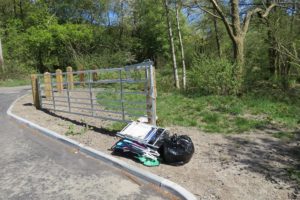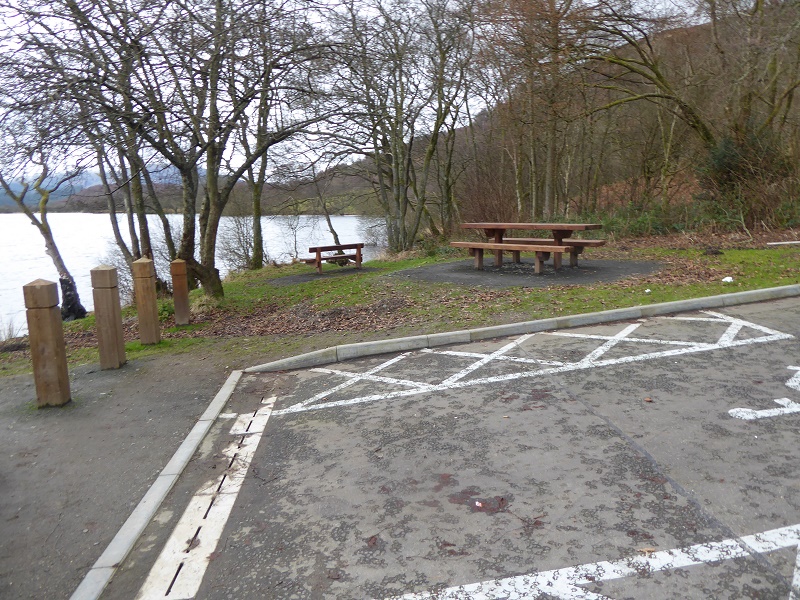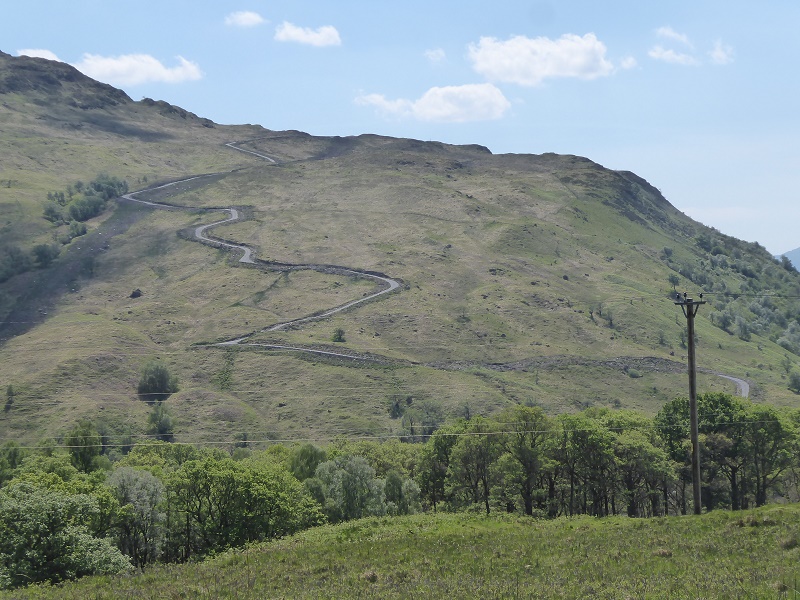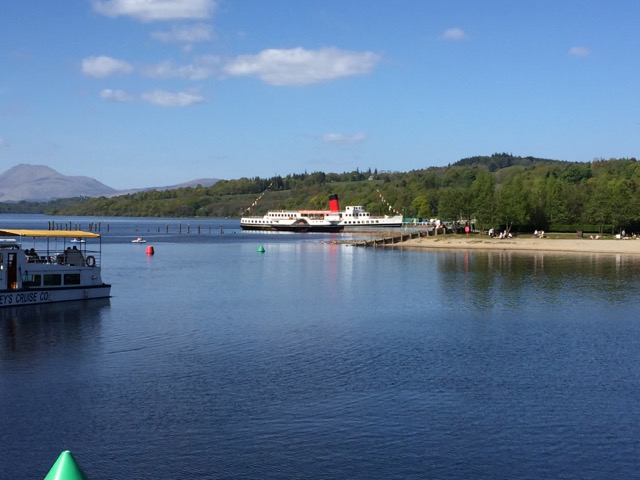By Nick Halls, resident of Ardentinny

The changing landscape of the National Park
I monitor the evolution of the Bye Laws and the incoherent manner of the implementation, by means of observation, talking to campers, visiting designated sites, reports contributed by ‘Parkswatchscotland’, and articles in magazines of Representative bodies of the physical activities in which I engage, which include camping associated with watersports and terrestrial activities.
I supported the creation of a National Park and worked to have Argyll Forest Park included. I have lived in the area of the LL&T National Park since 1969 and experienced nearly half a century of change, much of which has degraded the environment, depopulated communities of young people, reduced indigenous economic activity and local job opportunities. Not all of which lies at the door of the NP Authority, but it has done little to either slow or reverse the processes, despite the objectives of the NP. In fact, the NP Authority seems to reinforce the destructive impacts from which I imagined it would protect the area.
I observe daily the destructive impacts of motorists, near roadside camping, day visitors and egregious behavior of residents. I live amongst the land management practices of farmers, estates and Forestry Commission Scotland(FCS) and observe the degradation of the scenic quality of the National Park with dismay.


I have also noted the restriction of pleasurable free access, arising reversion of farmland to scrub and the ‘clear fell’ practices of FCS, encroachment of invasive non-native species, and enclosures designed to exclude deer. The hills are almost inaccessible other than by over used ‘popular’ routes – creating obvious landscape scars.
I am an ‘immigrant’ to the area but note with concern the progressive emigration of the indigenous population, for education, employment and improved life chances. My son who attended Dunoon Grammar, has only one or two school friends left in the area – he is now working in Canada. The indigenous population is progressively concentrated in suburban localities, while much of the more desirable property is used as either second or holiday homes or occupied by elderly retired incomers.
I believed naively the creation of a National Park would mitigate the damaging impacts arising from residents, land managers and visitors. I have been profoundly disappointed.
I have concluded the Governance of the National Park Board exemplifies the manner in which established vested interests, that actually have their ‘hands on the levers of power’ in Scotland, operate to secure influence by attaining appointments on the Boards of arms-length government agencies, that purport to serve the wider public interest, and then betray ‘people’s’ trust by subverting them in their own interest.
The eradication of space for camping from the National Park
It seems incredible that charging for camping, and by extension access, for a legal recreational activity in a National Park could ever have received endorsement by an SNP Minister of the Scottish Government. It discredits the very existence of the Scottish Parliament – and devalues the legislation it passes. Justifications presented in support of Bye Laws were flimsy at best, but could be presented as blatant misrepresentation to secure a predetermined outcome.
Provision for any sort of camping has been eradicated from the area progressively from the time I first arrived in 1969 – as camping sites evolved into first caravan parks then chalet developments – both much more intrusive than temporary camping. As confirmed by reference to OS and Bartholomew Tourist maps published prior to 1989.

These concentrated seasonal residential eyesores impose more pressure on public infrastructure, particularly sewerage and waste disposal, than any number of transient campers. They also degrade the natural qualities of the NP by a progressive urbanization, and pollute the aquatic environment surreptitiously – the shores of Loch Long, Loch Goil & Loch Lomond reveal plenty of evidence – fly tipping, cotton buds, toilet paper & sanitary towels are not dropped by shipping!

Significantly, under current legislative conditions, land that was once accessible has been converted into curtilage by close spaced semi-permanent temporary residences – a surreptitious usurping of what was once a ‘common good’ into exclusive compounds.
The architecture of these developments contrast with the vernacular building style, stimulating images of beach front caravan sites of a coastal resort or over-crowded chalet developments in an alpine resort. They fundamentally erode the integrity of the ‘uniquely Scottish’ nature of the Loch Lomond and Trossachs, so admired by artists of the 19th and 20th Century.


When I first arrived ‘wild’ camping was easy, but progressively every spit and exploitable piece of lower land has been either privatized, trashed by industrial forestry practice or over grown by non-native invasive species, such as Japanese Knot weed, Rhododendron, not to mention windfall, bracken & scrub.
A contributing factor has been decline in cattle & sheep farming, so formerly grazed areas are now overgrown. Suie Field and Cuilag exemplifies this feature, where the residual preferred camping options are now on the shingle beach.
The current situation is that there are very few accessible spaces to camp, and those that remain are intensively used by day visitors and campers. Progressive ‘privatization’ of accessible spaces and increased use of private cars for short visits to the NP have concentrated use, but the services to accommodate the use have not been provided.
All of this has been made explicit by numerous reports, press comment and user groups. It is not a recent ‘discovery’, it is as plain as the ever-lengthening noses on the faces of spokesmen for the NP Authority.

Many former informal sites have been converted into car parks/picnic sites – in favour of motorist and day visitors, at many of them camping is frowned upon. This exemplifies considerable public investment for one category of visitors at the expense of low cost provision for another. The necessary infrastructure for such concentrated use by day visitors has not been provided, such as bins, garbage disposal and toilets. There is no coherent provision to accommodate the requirements of visitors of any sort.

It escapes me as to why picnic tables proliferate, while being less than essential, while nice camping spots are eradicated. What ideology of visitor management validates this preference?
Evidence indicates campers are to be progressively driven from the Camping Management Zones and LL & T NP more generally.
The real problems faced by the National Park

The actual problems the NP has to confront are not ‘visitors’ but egregious land management practice, rural decay and the reversion of uneconomic farmland to marsh and scrub and fly tipping by residents. This ignores the vast tracks of land rendered inaccessible by industrial forestry practice, within which were farm towns with improved walled enclosures, charcoal burners platforms & hut platforms – reasonably drained and near water. All of which used to provide opportunities for camping.
This destruction of amenity is substantiated by pictorial evidence supporting reports – but to designate this sort of terrain as desirable camping locations, and charge for using it, is incomprehensible. There must be issues arising from Trades Description and Fraud legislation.
I cannot understand why Scottish Sports Association has not put pressure on both Sport Scotland and Ministers to review the operation of the Boards of both NPAs? The lack of consultation with representative bodies for sports and recreational activities is itself a disgrace, [except sporting estates] but the complete indifference to representations from bodies of all categories of users of the NP’s in preference to a spineless subservience to the interests of landowners/managers and influential residents surely cannot be tolerated any longer. Particularly so, as private interests seem to be obscured by the practice of holding unrecorded ‘pre-agenda’ meetings to ensure outcomes of subsequent Public Meetings, during which interests of Board Members are not declared or recorded.

Specific concerns arise in the case of hydro works in Glen Falloch, unrestricted construction of intrusive estate infrastructure on wild land, appallingly unaesthetic commercial forestry practice, and to top it all the, proposals for ‘Flamingo land’, as if a Scottish National Park is the equivalent of Center Parks or a Funfair, or in the case of Lomond Shores, Blackpool!

It makes one wonder if the Board/Authority can distinguish between a Regional Park recovered from an industrial wasteland in the midst of a conurbation and conserving an iconic area of wild land, the history of which underpins the Scottish national identity.
I note the CV of James Stuart, it will be of interest to see whether he is just another ‘safe pair of hands’ appointed to protect vested interest, or whether he can change the culture of the LL & T NP Board. It will also be interesting to see whether the new councillors serving the constituencies within the NP boundaries, will treat the NPA as just another local authority and a vehicle for promoting their electoral interests.
Whatever emerges I fear it will not enhance the reputation of NP’s in Scotland, or enhance the environmental quality of the land for which the NP Board have planning responsibility. It will demonstrate how Scotland is ‘actually’ governed, and how little real concern exists for a ‘Fairer and more Equal’ Scottish Society.
Attitudes of Park staff
Recently, I was informed by a Ranger that the bye laws were necessary to exclude ‘travellers’ from the NP [by which I assume he meant Tinkers/Gypsies] who annually made a mess of camping places – to co-opt my sympathy on the assumption that I would naturally agree that such lower order socio-economic scum should not be allowed use the NP, or upset the largely middle class ‘blow ins’ who have replaced the indigenous population. There is no evidence whatever that the mess left by visitors both day and overnight can be attributed to any particular sector of society, other than highly subjective guesswork. There is ample evidence that the fly tipping, of which there are examples everywhere, is the responsibility of residents.
He also mentioned that tidying up the NP, by exclusion of campers, was an imperative because foreign visitors, particularly those traversing the West Highland Way, remarked on the quality of the Scottish Scenery but bemoaned the litter everywhere. This underlines the lack of a litter management strategy, but hardly validates the exclusion from preferred camping sites nowhere near the West Highland Way.
It is hard not to conclude that training of NP personnel involves reinforcement of social prejudice, that evidence they see every day must throw open to question.
Politics and the national interest
In the context of the lead up to an election in which constitutional issues will be influential, opinion about the detail of the ‘actual’ governance of Scotland is relevant.
It is appropriate to comment on abuse of position and influence and disregard for Scottish Law, in pursuit of objectives that reinforce social exclusion and private interest at the expense of the ‘common good’.
There is such dissonance between political pronouncements and the reality that it raises concern that Ministers of the Scottish Government consciously collude or are out of touch! One wonders whether civil servants, parliamentary secretaries and constituency workers, who presumably monitor the press and other media, are keeping Ministers properly informed – or colluding in misrepresentation and abuse of power and due process – because they are in sympathy with it!
This raises the issue of ‘who actually governs Scotland’ and whether the declared social aspiration of the SNP is being subverted or are just hollow. Strong & Stable [actually indecisive and floppy] versus Fighting for Scotland’s interests [actually weak and ineffective] while incapable of implementing any change worthy of notice, and presiding over socially regressive initiatives reinforcing the least palatable aspects of the Scottish social scene, of which they seem blissfully unaware.
The Governance of the NP Authorities and the accountability of senior officers is the issue under consideration, but the devious unaccountable nature of HIE, SNH, MOD, SEPA, FCS & the landowning interests with which they apparently closely identify is also becoming explicit.
The question has to be asked, ‘who disinterestedly speaks for the actual benefit of the majority of Scottish people’, and whether their voice should be heard? The evidence seems to suggest that democratically organized representative bodies, charities and voluntary undertakings are treated with contempt.

Landowners and commercial interests have an unhealthy influence in the governance of the National Park from above and from inside the authority itself. Could it be even the planning department are implicated after their failures to enforce contraventions in consent both in commercial developments and by the National Park Authority itself.?
It is clear a National Park System can withstand it’s fools and even the ambitious but it cannot withstand treason from within, where the very aims of the National Park System are undermined for the benefits of hidden agendas and Government Plans. The claims of openness and accountability at all levels of Scottish Government are a sham with ministers turning a blind eye to the irregularities and the ethical issues raised in our National Parks.
This National Park Authority has lost the respect of the people and quite deservedly so. They now openly lie with impunity, they show a marked disregard for heath and safety, trades description and the rights of the individual to access the National Park. They make up criminal offences on a whim and enact them through their byelaws to the detriment of law abiding park users. This is all done without fear of reproach as the laws of the land do not appear to apply to the National Park Authority and Ministers of all parties stand by and watch as these travesties are playing out.
There is indeed something rotten in the State of Scotland that is reflected in recent, and not so recent, goings on in LLTNP. As the prevalence of tarmac, fences, gates, semi-urbanised glamping lures and environmentally catastrophic hydro schemes has increased, so my patronage of this once beautiful area has withered to nothing beyond travelling through it to reach places that are – still, but for how long? – more democratically enjoyable.
Excellent post and comment. Good to see the lid coming off Pandora’s box at last.
It is a waste of time complaining to the Scottish government they send complaints to the national park authority (friends )still waiting on a dozen replys the ones that I have are poor sound bite type responses .
Stepen,
I have seen that myself with SEPA where ex employees of the Park contact their friends in the park authority after receiving a complaint, then fail to act on the complaint but on the next visit to site (Loch Chon Campsite) miraculously the issues have been resolved or partially resolved.
It is also clear that there are problems with building control when a completion certificate is issued even when the installation (Loch Chon Campsite) is clearly incomplete and does not conform with the planning permission layout drawings.
I totally agree with the writer . LLATNP approving FLAMINGOLAND says it all .